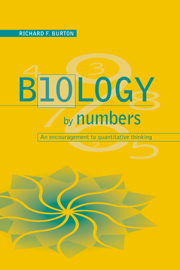Book contents
- Frontmatter
- Contents
- Preface
- A guide to the book
- 1 Putting two and two together
- 2 Units, formulae and the use of old envelopes: confronting some obstacles to quantitative thinking
- 3 Aspects of energy metabolism
- 4 Getting things in proportion
- 5 Perilous percentages, dangerous ratios
- 6 Building a trophic pyramid
- 7 Sodium in animals and plants
- 8 Exchanges of water and carbon dioxide
- 9 A geometric series
- 10 Introduction to logarithms
- 11 Bringing logarithms to life
- 12 Exponential relationships
- 13 Aspects of allometry
- 14 More on allometry, and on quantitative patterns in nature
- 15 How the abundance of food affects rates of feeding
- 16 The characterization of trees and other branching systems
- 17 Epilogue
- References
- Notes
- Index
11 - Bringing logarithms to life
Published online by Cambridge University Press: 05 June 2012
- Frontmatter
- Contents
- Preface
- A guide to the book
- 1 Putting two and two together
- 2 Units, formulae and the use of old envelopes: confronting some obstacles to quantitative thinking
- 3 Aspects of energy metabolism
- 4 Getting things in proportion
- 5 Perilous percentages, dangerous ratios
- 6 Building a trophic pyramid
- 7 Sodium in animals and plants
- 8 Exchanges of water and carbon dioxide
- 9 A geometric series
- 10 Introduction to logarithms
- 11 Bringing logarithms to life
- 12 Exponential relationships
- 13 Aspects of allometry
- 14 More on allometry, and on quantitative patterns in nature
- 15 How the abundance of food affects rates of feeding
- 16 The characterization of trees and other branching systems
- 17 Epilogue
- References
- Notes
- Index
Summary
How do logarithms come into biology?
The previous chapter pointed out the practical usefulness of logarithmic scales in coping graphically with quantities that span many orders of magnitude. However, when the particular data of Table 9.1 (the geometric series 1, 2, 4, 8, 16, etc.) were so treated (i.e. the logarithm of 2n was plotted against n), a relationship emerged that is conveniently linear (Figure 10.1). This always happens when one variable, Y (in that case 2n), changes always by a constant proportion (i. e. in constant ratio) for a given absolute change in another variable, X(X = n in that case, but very often it is time). This is the basis for many of the logarithmic relationships in biology, meaning specifically those in which log Y is linearly related to X, or, in terms of an equation, in which log Y = CX + k (where C and k: are positive or negative constants). This is an important point and merits emphasis through re-statement:
Logarithmic relationships (such that log Y shows a linear relationship with X) occur in situations where the absolute value of the variable Y changes with X at a rate that is proportional to the current, instantaneous value of Y.
(Some readers will no doubt realize that I am writing here as much about exponential relationships as about logarithmic ones, for these are essentially two sides of the same coin.)
It may help to look at the series 1, 2, 4, 8, 16, etc. in the light of the above statement.
- Type
- Chapter
- Information
- Biology by NumbersAn Encouragement to Quantitative Thinking, pp. 113 - 123Publisher: Cambridge University PressPrint publication year: 1998



